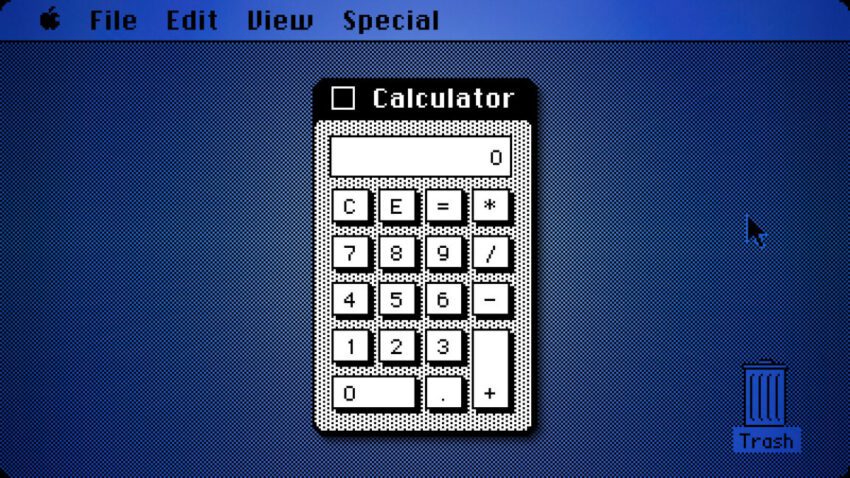
original mac calculator design came from letting In a fascinating twist of design history, the original calculator for the Macintosh was shaped by a brief yet impactful interaction between Steve Jobs and an Apple programmer.
original mac calculator design came from letting
The Context of Innovation at Apple
In the early 1980s, Apple was on the cusp of a technological revolution with the development of the Macintosh, which would eventually be released in January 1984. The company was known for its innovative approach to personal computing, and this was largely driven by the vision of its co-founder, Steve Jobs. Jobs was notorious for his intense focus on design and user experience, often pushing his team to achieve perfection. This relentless pursuit of excellence, however, sometimes led to friction between Jobs and his employees.
In February 1982, Apple employee #8, Chris Espinosa, faced a challenge that many in creative fields can relate to: a micromanaging boss. Jobs had been critiquing Espinosa’s design for the Mac’s calculator, leading to a series of frustrating revision cycles. Espinosa, who was only 21 at the time, found himself in a position where he needed to balance his creative vision with the demands of a demanding leader.
Espinosa’s Innovative Solution
After enduring days of feedback and revisions, Espinosa devised a clever solution to the problem. He created what he called the “Steve Jobs Roll Your Own Calculator Construction Set.” This innovative approach allowed Jobs to take the reins of the design process, giving him the opportunity to create a calculator that met his standards. By allowing Jobs to play with the design elements, Espinosa effectively turned the critique process into a collaborative effort.
This anecdote highlights a unique aspect of the creative process at Apple during its formative years. Rather than adhering strictly to traditional design protocols, Espinosa’s approach allowed for a more organic and interactive form of development. By letting Jobs experiment with the design, Espinosa not only alleviated some of the pressure he was under but also fostered a sense of ownership in Jobs, who was known for his hands-on approach to product development.
The Role of Folklore.org
This delightful story comes from Andy Hertzfeld’s Folklore.org, a well-respected archive that chronicles the history of the original Macintosh. Hertzfeld, a key member of the Macintosh development team, has dedicated significant effort to preserving the stories and experiences of those who contributed to the project. Folklore.org serves as a valuable resource for anyone interested in the early days of personal computing and the culture that surrounded it.
The site captures not only the technical challenges faced by the team but also the interpersonal dynamics that influenced the development process. In an era where software design often comes through committee, stories like Espinosa’s remind us of the importance of individual creativity and collaboration in the innovation process.
Chris Espinosa: A Brief Biography
Chris Espinosa’s journey with Apple began at a remarkably young age. He started working for the company at just 14 years old in 1976, making him the youngest employee at the time. His early experiences at Apple provided him with a unique perspective on the tech industry and the creative process. By 1981, while studying at UC Berkeley, Espinosa was persuaded by Jobs to leave his studies and join the Macintosh team full-time.
Espinosa’s contributions to the Macintosh project were significant, and his story serves as an example of how young talent can thrive in a fast-paced, innovative environment. His ability to navigate the challenges posed by Jobs’ management style speaks to his adaptability and creativity, qualities that are essential in the tech industry.
The Impact of Steve Jobs on Design Philosophy
Steve Jobs’ influence on design and product development cannot be overstated. His insistence on simplicity, elegance, and user-centric design has left a lasting legacy in the tech world. Jobs believed that technology should be intuitive and accessible, a philosophy that guided the development of the Macintosh and its applications, including the calculator.
Jobs’ approach often led to intense scrutiny of design elements, as he sought to eliminate anything that could detract from the user experience. This relentless focus on perfection sometimes created tension within his teams, as seen in Espinosa’s experience. However, it also fostered an environment where innovation could flourish, as team members were encouraged to push boundaries and explore new ideas.
The Calculator’s Design and Functionality
The calculator that emerged from this collaborative effort was not just a functional tool; it was a reflection of the design ethos that Jobs championed. The Macintosh calculator was designed to be user-friendly, with a clean interface that made it accessible to a wide range of users. This focus on usability was a hallmark of the Macintosh, which aimed to democratize computing by making it approachable for non-technical users.
In the context of the early 1980s, the design of the Macintosh calculator was groundbreaking. It incorporated features that were not commonly found in other calculators of the time, such as the ability to perform complex calculations and a graphical interface that set it apart from its competitors. This innovative design was a direct result of the collaborative efforts between Espinosa and Jobs, showcasing how effective teamwork can lead to remarkable outcomes.
Lessons Learned from the Experience
The story of the Macintosh calculator serves as a valuable case study in the importance of collaboration and adaptability in the design process. Espinosa’s decision to involve Jobs in the design allowed for a more dynamic and creative outcome, demonstrating that sometimes the best solutions come from embracing input from all stakeholders.
In today’s fast-paced tech environment, where design processes often involve multiple layers of approval and feedback, Espinosa’s approach offers a refreshing perspective. It highlights the potential for innovation when team members are encouraged to engage with one another and share their ideas openly. This lesson is particularly relevant in an age where many software designs are created through committee, often leading to diluted creativity and compromised user experiences.
Stakeholder Reactions and Industry Implications
The anecdote surrounding the Macintosh calculator has garnered interest from industry professionals and historians alike. Many see it as a testament to the unique culture at Apple during its early years, characterized by a blend of creativity, innovation, and a willingness to challenge the status quo. The story has resonated with designers and developers who aspire to create products that prioritize user experience while also fostering a collaborative environment.
Moreover, the implications of this story extend beyond Apple. It serves as a reminder to tech companies and startups about the importance of nurturing a culture that values individual contributions and encourages open dialogue. In an industry that is constantly evolving, fostering an environment where creativity can thrive is essential for long-term success.
Conclusion
The original design of the Macintosh calculator is a fascinating chapter in the history of personal computing, illustrating the interplay between leadership, creativity, and collaboration. Chris Espinosa’s innovative solution to involve Steve Jobs in the design process not only resolved a challenging situation but also resulted in a product that embodied the principles of user-centric design.
As we reflect on this story, it becomes clear that the lessons learned from the early days of Apple remain relevant today. In a world where technology continues to shape our lives, the importance of collaboration, adaptability, and a focus on user experience cannot be overstated. The legacy of the Macintosh and its calculator serves as a reminder that great design often emerges from the willingness to engage with diverse perspectives and embrace the creative process.
Source: Original report
Was this helpful?
Last Modified: November 12, 2025 at 7:37 pm
0 views















